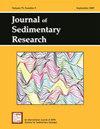美国犹他州水晶间歇泉泉水碳酸盐的快速成岩作用和微生物生物特征降解。
IF 2.1
4区 地球科学
Q1 GEOLOGY
引用次数: 0
摘要
碳酸盐岩在露头至毫米尺度上保存了完好的生物相关结构记录;然而,细胞化石等微观特征却鲜有体现。古碳酸盐岩中缺乏微观纹理信息通常被归因于与碳酸盐成岩有关的过程。然而,关于这些破坏过程如何发生以及何时发生的确切例子相对较少,尤其是在活跃的沉淀系统中。为了更好地了解碳酸盐沉淀环境在早期成岩过程中的成岩过程,我们研究了位于犹他州格兰德县的一个活跃的冷水碳酸盐泉(18 ∼ °C)--水晶间歇泉(Crystal Geyser)。在这里,我们发现快速沉淀能够有效地捕捉细胞状结构,并形成相关的微尺度层状叠层石;然而,这些形态在形成后会立即退化。我们将破坏性成岩作用归因于可转移的文石重结晶为更稳定的多晶体方解石(即反转)以及相关的纹理粗化,这种粗化使原始结构均匀化并被抹除(即退化新形态)。尽管失去了微观形态信息,但以大分子有机物形式存在的化学生物特征仍然散布在被破坏的碳酸盐岩纹理中。这些观察结果为碳酸盐岩中原始微尺度纹理的消失提供了半同期成岩作用的实例。类似的机制及其快速发生的时间(如本文所示)很可能是许多古碳酸盐岩中缺乏微观形态生物特征的原因。这项工作进一步强调,在这类系统中,必须在沉积后迅速通过更稳定的结晶相(如白垩相)进行过矿化作用,才能在地质时间尺度上有效地保留这些特征。本文章由计算机程序翻译,如有差异,请以英文原文为准。
Rapid diagenesis and microbial biosignature degradation in spring carbonates from Crystal Geyser, Utah, U.S.A.
Carbonate rocks retain a well preserved record of biologically associated structures at the outcrop to millimeter scale; however, microscale features such as cellular fossils are rarely represented. The lack of microscale textural information in ancient carbonates is commonly attributed to processes relating to carbonate diagenesis. However, there are relatively few examples of precisely how and when these destructive processes occur, particularly in active precipitating systems. To better understand the taphonomy of carbonate precipitating environments through early diagenesis, we investigated Crystal Geyser, an active cold-water carbonate spring (∼ 18°C) located in Grand County, Utah. Here we show that rapid precipitation is effective at initially capturing cell-like structures and forming associated microscale laminated stromatolites; however, these morphologies degrade immediately after their formation. We attribute destructive diagenetic effects to the recrystallization of metastable aragonite into the more stable polymorph calcite (i.e., inversion) and the associated textural coarsening that homogenizes and erases the original fabric (i.e., aggrading neomorphism). Despite the loss of microscale morphological information, chemical biosignatures in the form of macromolecular organics remain dispersed throughout the disrupted carbonate textures. These observations provide an example of penecontemporaneous diagenesis that obliterates primary microscale textures in carbonate rocks. Similar mechanisms and their rapid timing, as shown here, likely contributes to the observed lack of microscale morphological biosignatures in many ancient carbonates. This work further highlights that in such systems, permineralization by a more stable crystalline phase, such as chert, must occur rapidly after deposition to effectively retain these signatures over geological timescales.
求助全文
通过发布文献求助,成功后即可免费获取论文全文。
去求助
来源期刊
CiteScore
3.80
自引率
5.00%
发文量
50
审稿时长
3 months
期刊介绍:
The journal is broad and international in scope and welcomes contributions that further the fundamental understanding of sedimentary processes, the origin of sedimentary deposits, the workings of sedimentary systems, and the records of earth history contained within sedimentary rocks.

 求助内容:
求助内容: 应助结果提醒方式:
应助结果提醒方式:


